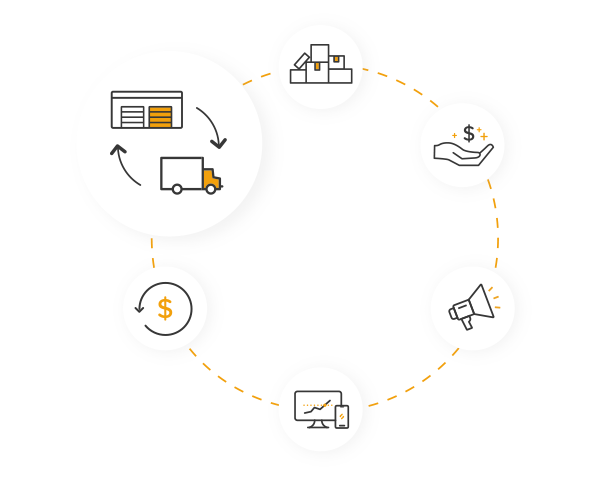Introduction
When it comes to retail, the art of selling is only one side of the coin. But when a product doesn’t quite meet the mark whether because of fit, quality, or something completely subjective— retailers face the often-dreaded return. Then the science of returns management comes into play. Yet, retailers, brands and third-party logistics (3PL) providers find themselves navigating a myriad of challenges with returns. So, how can retailers mitigate both the financial and operational impact of returns on their business and perhaps even transform disappointment into delight? The answer lies in a returns management system.
In this article we’ll cover:
- Challenges of returns management
- What is a Returns Management System (RMS)?
- Who needs an RMS?
- Where does RMS sit in the retail tech stack?
- Benefits of an RMS
- Technology options for returns management
Top 3 Challenges of Returns
Lack of Prioritization & Ownership
Managing returns can be a complex, cumbersome process. The first challenge is the mindset many retailers have around returns, Gartner found that “68% of retailers treat returns as a cost of doing business.” So rather than looking at returns as an area for improvement, many view it as too complex to solve in a meaningful way. Gartner also found that half of retail respondents said “reverse logistics operation lacks clear ownership” at the executive level, so understanding who owns solving the dilemma of returns can result in it becoming an ignored part of the business.
Tedious, High-Touch Processes
Another challenge of managing returns is the complexity involved. Outbound fulfillment can more simply be picked, packed, and shipped. However, with a return retailers need to confirm that the product returned is the correct item, in the reported condition, and decide what to do with the returned item next. It is a hands-on, nuanced process based on the product itself and the economics of performing high-touch processes.
Margin Erosion
Given that inventory is one of the highest costs for retailers, return backlogs can lead to delayed revenue realization and even worse, markdowns or liquidation. Margin erosion has led many retailers to recently begin charging for returns, including Amazon in some instances.
“Return policies can put you out of business,” notes Shep Hyken, customer service expert. “Retailers must walk a fine line between the cost of convenience and the cost of losing customers due to lack of convenience” (Forbes)
What is a Returns Management System?
A returns management system (RMS) is a technology platform that spans the entire returns lifecycle — from return initiation, return methods, shipping consolidation, dispositioning, and ultimately restock and resale. While there are disparate returns solutions available, a true RMS will cover the end-to-end return journey:
- Offer return initiation via a front-end, customer-facing return portal and nudge customers to exchange an item where applicable
- Facilitate multiple return methods i.e. drop-offs, pick-ups, lockers, mail back, BOPIS, etc.
- Consolidate returns to reduce shipping costs back to the distribution center
- Return processing to receive, sort, test/grade, and disposition the product to its next-best destination, whether restock, resale, or recycle/refurb.
- –> Read more about the touchpoints of the returns lifecycle
Retailers often piecemeal a returns solution together with disparate technologies, as front-end technology is usually owned by digital teams, and back-end technology is owned by operational teams. This creates tension and adds to the returns dilemma— do you focus on driving growth through great customer experiences, or focus on minimizing costs? With disparate technology, retailers can solve one problem with returns, to only create another challenge in another part of the business. (I.e. expanding the return window leading to a longer returns lifecycle and more operational backlogs)
By leveraging a unified RMS and applying “systems thinking” you can understand the entire journey of a return, share data throughout the process, and optimize the end-to-end experience— for the business and consumers.
Who needs a returns management system (RMS)?
Given the complexity and margin erosion associated with retail returns, many vendors are looking for solutions to mitigate the impact on their business. However, certain organizations will experience the greatest return on investment (ROI) with a dedicated RMS.
Generally speaking, retailers with a significant volume of returns have the greatest need, but any retailer or brand with over a 10% return rate should explore an RMS. Certain retail categories have higher return rates than others — namely apparel, accessories, footwear, bags, cosmetics, sporting goods, and home goods (Source). As a result, brands in these categories are likely the ones that have a keen focus on reducing unnecessary returns, converting returns to exchanges to save the sale, and shortening the time to restock and resale for available-to-sell (ATS) returned items.
Any retailer or brand with over a 10% return rate should explore an RMS
Additionally, while larger enterprise retailers have been the earlier adopters of RMS, more midsize to smaller retailers are considering RMS as they look to choose solutions poised to help them scale and grow. While a spreadsheet, ecommerce plugin, or WMS workaround may work initially— fast-growing retailers often gain high yields from the right technology investments.
Anywhere there are returns, there is an opportunity to enhance the customer experience, optimize the returns process, and reduce waste and backlogged inventory as a result of inefficient technology and processes.
Where does RMS sit in the retail tech stack?
RMS dovetails nicely into the commerce and supply chain technology stack that retailers, brands, and 3PLs are already know and trust. Since RMS spans the customer-facing storefront (return initiation) through the back-end operational technology (i.e. WMS or SCE), it weaves return insight and data into the key systems that are driving business decisions and processes and curating the best customer experience.
This is one reason more retailers are ditching monolithic technology for returns, and selecting a modern RMS approach to development and deployment — a microservices-based, API-first, cloud-native, headless architecture. Sometimes referred to as “composable” commerce, the mindset is really that retailers, brands, and 3PLs and select the right elements of technology that make sense for their business.
As Gartner notes, “enterprises often purchase software from different vendors to obtain the best-of-breed offering for each application area.” As more organizations move to the best-of-breed approach to technology selection, RMS is the only purpose-built technology aimed at mitigating the impact of returns holistically, both to your customer and your bottom line.
Benefits of a Returns Management System
More control of your returns experience
The biggest challenge with returns is that a negative returns experience will not only deter customers from shopping with you in the future, but they are more likely to share their negative experience with their network. An RMS gives your organization the ability to craft the ideal returns experience.
For example, you can elect to offer a personalized returns experience to shoppers based on previous purchase history. If you know a shopper is a repeat customer, you can offer an instant exchange where the replacement item ships immediately, without having to wait for the returned item or a refund to process.
An RMS gives you the tools to craft the ideal experience, while keeping processes, margin, and profit in mind.
Reduce unnecessary returns
Returns have been an evergreen challenge in retail, leading many retailers to try and unlock the key to total returns avoidance. This mindset often leads to restrictive returns policies that will deter customers from purchasing to begin with. In fact, 60% of consumers reported NOT shopping with a retailer simply because they didn’t like their returns policy. (Source: Optoro)
An alternative way of thinking about returns is categorizing them into different buckets:
- Preventable returns: Purchases where customers may make a different buying decision had they been provided more or different information. For example, if they are unsure of the “fit” for a shirt, they may bracket their order with a few sizes with the intent to return the ones that don’t fit. Providing sizing information, virtual try-on tools, or models with a variety of body types can help mitigate the practice of over ordering with the intent to return.
- Unpreventable returns: Purchases where customers are making a return for reasons outside of their control. Examples of this can be damaged or defective items, receiving the wrong item altogether (size, color, SKU), or time-sensitive items arriving outside of the expected delivery window.
A modern RMS should be able to identify certain products or SKUs that have high return rates and low resale rates, to offer customer-facing optimization tips to reduce unnecessary returns. For example, the ability to understand return reasons at the unit level can help you make better merchandising decisions in the long run. Similarly, having insight into items that are often “bracketed” can help your digital team develop innovative front-end experiences like virtual try on or “see it in the room” technology.
Because an RMS spans the entire return lifecycle, it can use SKU-level returns data from the front and back-ends to begin to predict the most cost-efficient outcomes for items earlier in the return process. For example, providing early dispositioning to send low-value items directly to liquidation or recycling can prevent unnecessary processing work and minimize touches within the reverse supply chain.
Nurture a Repurchase
Bracketing, or the practice of over-ordering with the intent to return, surged during the pandemic. In fact, in 2022 ~60% of shoppers resorted to bracketing an order, up 20% from 2017 (Source).
However, given recent studies show the cost to acquire a new customer is 7x the cost to retain the current customer, the case for presenting a frictionless way to encourage a repurchase (via exchange or gift cards) is one way to damper the impact of a return. And it can even be more profitable to nurture the right returners. Just as omnichannel shoppers spend more both in cart size and customer lifetime value, recent research shows that returners are 4x more profitable than non-returning customers (Source).
Studies also show that consumers view money refunded from a return as “free money” and have a higher propensity to respend that money versus re-budget that money. A modern RMS will help retailers convert more returns to exchanges — saving the sale and driving higher customer lifetime value.
Faster processing & restock
Managing inventory levels is an evergreen challenge for brands and retailers, and returns can often create a time-consuming backlog within the warehouse. Returns are inherently a high-touch process, as each return needs a validation of the product and physical evaluation of the condition. While the customer-selected return reason is helpful for understanding returns, confirming reason codes is critical for long-term optimization of merchandising strategies.
A modern RMS will accelerate the receiving, dispositioning, and time to restock for returned items, ultimately reducing the need to pad inventory levels (i.e. over purchase), driving up holding costs, increasing markdowns, and reducing profit margin.
Less environmental impact
Returns can have a significant impact on their environment. With inefficient returns processes, not only does more product up in landfills, but there are more carbon emissions from double-transportation cost.
With RMS, retailers, brands and 3PLs can make environmentally-conscious decisions about how to best manage their returns with the least impact on the planet.
—> Check out Optoro’s Impact Report
Options for Managing Returns
Many retailers and brands have a piecemeal or workaround approach to managing returns. They may use front-end technology to solve the consumer-facing portion of returns, and then use back-end operational software to handle the physical processing of returns.
There are a few options for managing returns, and there are pros and cons to each approach, and/or combination thereof.
| Option | Pros | Cons |
| Use a workaround in your WMS (Read more on WMS vs. RMS) | Can be cheaper initially Already know the tech provider | Not built with intentionality for returns Excludes front-end data & insight Lacks RMA creation capabilities Lacks tracking for returns May require development work |
| Use a workaround in your OMS | Centralized order data in one place Can be cheaper initially Already know the tech provider | Not built with intentionality for returns Lacks RMA creation capabilities Lacks “4 wall” processing capabilities May require development work |
| Build a returns solution in house | More control of your tech stack Customized to your business Built by brand SMEs | Costly to maintain Complex to build without returns expertise Difficult to remain competitive with ever-changing returns landscape (fraud, omnichannel returns, etc.) IT resource drain |
| Leverage a standalone returns portal | Can be easy to implement Brandable experience Robust functionality (exchanges, tracking, etc.) | Disconnected from physical return processing Lacks “4 wall” processing capabilities |
| Leverage standalone processing technology for returns | Robust processing functionality Can reduce return backlog Can increase speed to stock | Can be expensive to customize Disconnected from shopper-facing returns experience (RMA creation, reason for return, etc.) |
| Returns management system (RMS) | Same benefits of portal & processing technology Full end-to-end visibility into returns Shared data model for better optimization & fraud prevention “System thinking” to solve returns challenge | Can be difficult to select the right fit May have more features than you need May require development work |
As the challenge of managing returns has grown, so has the need for a dedicated, built-for-purpose system to help solve the unique challenges.
Summary
While returns management remains an evergreen challenge to solve, the right processes coupled with the right technology system can help retailers move from simply weathering the storm, to transforming returns as a way to surprise and delight customers and drive loyalty.
White Paper
The Returns Dilemma: How to Avoid the Cost-or-Revenue Trap
Balancing a great customer experience and mitigating the cost of returns is an evergreen conundrum for retailers. Download the Returns Dilemma to understand the latest research around returns (hint: it’s becoming a more critical challenge to solve) and how to approach returns with a holistic mindset.

Natalie Walkley
Vice President, Marketing
Natalie has spent the last 15 years in marketing, with the last 7 years in supply chain technology for retailers and 3PLs. When she’s not geeking out about ecommerce news, she may be supporting brands through retail therapy. Natalie lives in the music capitol of the world (Nashville, TN) with her husband and three children.

Natalie Walkley
Vice President, MarketingNatalie has spent the last 15 years in marketing, with the last 7 years in supply chain technology for retailers and 3PLs. When she’s not geeking out about ecommerce news, she may be supporting brands through retail therapy. Natalie lives in the music capital of the world (Nashville, TN) with her husband and three children.
